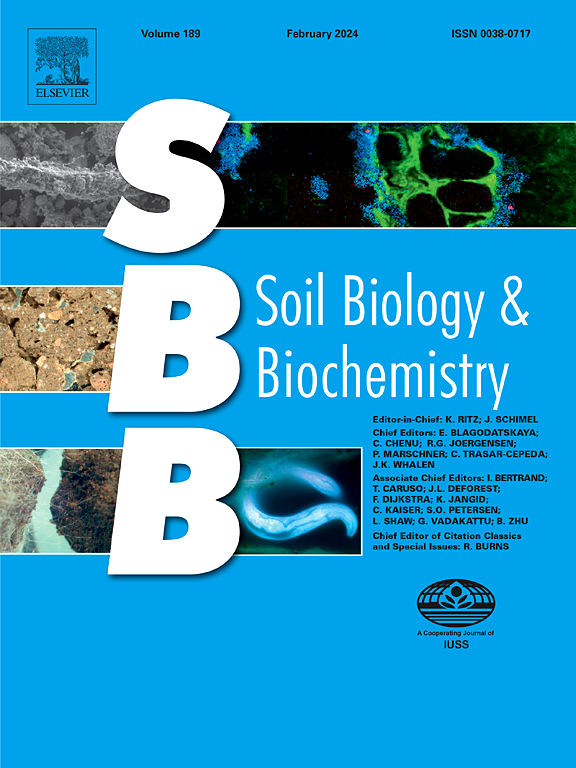The effects of climate warming and exogenous nitrogen input on soil N2O emissions from mangroves
IF 9.8
1区 农林科学
Q1 SOIL SCIENCE
引用次数: 0
Abstract
The paucity of studies on nitrous oxide (N2O) dynamics with rising temperatures and nitrogen (N)-based eutrophication makes it challenging to evaluate the role of mangroves in mitigating climate change. Here, a 3-year mesocosm experiment was conducted to investigate the effects of climate warming (+3 °C) and excessive N input (25 mg N L−1) on soil N2O emissions from two mangroves (Avicennia marina and Bruguiera gymnorrhiza). We found that warming and N input alone significantly increased soil N2O emissions from both mangroves, while the interactive effects of warming and N input on soil N2O emissions were affected by mangrove species. Warming mitigated the positive effect of N input on soil N2O emissions from A. marina; and amplified the effect of N input on soil N2O emissions from B. gymnorrhiza, suggesting that the response of soil N2O emissions to these global change factors is species-dependent. Stable isotopic signature analysis revealed that both warming and N input significantly increased the relative contribution of nitrification to N2O emissions from A. marina; whereas N input, rather than warming, significantly changed the relative contribution of nitrification in B. gymnorrhiza. This could be attributed to the differential changes in soil environmental conditions, plant growth and the microbial structure of the two mangroves. Overall, this study highlights the role of mangrove species in modifying the effects of warming and N input on soil N2O emissions, which should be considered when accurately projecting N2O emissions from mangroves. Furthermore, considering the low N2O emissions from background sediments and the common N limitation across mangroves, our findings suggest that climate warming and exogenous N input may lead to a surge of N2O emissions from mangroves, especially those that are seriously affected by human activities.
气候变暖和外源氮输入对红树林土壤一氧化二氮排放的影响
关于一氧化二氮(N2O)随温度升高和氮(N)富营养化而变化的研究很少,这使得评估红树林在减缓气候变化方面的作用具有挑战性。在此,我们进行了一项为期 3 年的中观实验,研究气候变暖(+3 °C)和过量氮输入(25 毫克 N L-1)对两种红树林(Avicennia marina 和 Bruguiera gymnorrhiza)土壤氧化亚氮排放的影响。我们发现,单独升温和过量氮的输入会显著增加两种红树林的土壤一氧化二氮排放量,而升温和过量氮的输入对土壤一氧化二氮排放量的交互影响则受红树林物种的影响。变暖减轻了氮输入对A. marina土壤N2O排放的积极影响;放大了氮输入对B. gymnorrhiza土壤N2O排放的影响,这表明土壤N2O排放对这些全球变化因素的反应取决于物种。稳定同位素特征分析表明,气候变暖和氮输入都显著增加了A. marina的硝化作用对N2O排放的相对贡献;而氮输入(而不是气候变暖)显著改变了B. gymnorrhiza的硝化作用对N2O排放的相对贡献。这可能是由于两种红树林的土壤环境条件、植物生长和微生物结构发生了不同的变化。总之,这项研究强调了红树林物种在改变气候变暖和氮输入对土壤一氧化二氮排放的影响方面所起的作用,在准确预测红树林的一氧化二氮排放时应考虑到这一点。此外,考虑到背景沉积物的 N2O 排放量较低以及红树林普遍存在的 N 限制,我们的研究结果表明,气候变暖和外源 N 输入可能会导致红树林的 N2O 排放量激增,尤其是那些受到人类活动严重影响的红树林。
本文章由计算机程序翻译,如有差异,请以英文原文为准。
求助全文
约1分钟内获得全文
求助全文
来源期刊

Soil Biology & Biochemistry
农林科学-土壤科学
CiteScore
16.90
自引率
9.30%
发文量
312
审稿时长
49 days
期刊介绍:
Soil Biology & Biochemistry publishes original research articles of international significance focusing on biological processes in soil and their applications to soil and environmental quality. Major topics include the ecology and biochemical processes of soil organisms, their effects on the environment, and interactions with plants. The journal also welcomes state-of-the-art reviews and discussions on contemporary research in soil biology and biochemistry.
 求助内容:
求助内容: 应助结果提醒方式:
应助结果提醒方式:


